Speedgoat 50K 2024 Race Report

My third time completing the Speedgoat 50K has been the most humbling. Every time I do this race I come away shredded by the demands of the endless hill climbs that wreck all semblance of confidence I had in training. But this year I thought it might be different and that my training had better prepared me. It didn’t turn out that way. This is the intention of race inventor, Karl Meltzer:
“The course is set up to mentally demoralize you”
The race course has changed over the years but stays mostly the same. From the Snowbird Ski Resort parking lot you run up to Hidden Peak, down around Mineral Basin, back up to Mount Baldy, down again a bit, up the Hidden Peak ridge, and then finally down to where you started at the Snowbird Ski Resort parking lot.
In 2015 the course was 31.3 miles with 12,139 ft of elevation gain. I did it in 11:44. Two years later in 2017 the course was 33.7 miles long with 11,236 feet of elevation gain. I did that one in 10:35. This year, in 2024, the course was 32.8 miles long and had an elevation gain of 11,400 feet. I did it in 11:46.
Training Preparation
This race is difficult to train for due to the unique and aggressive elevation gain and loss throughout the course. All while above 8,000 feet of elevation. The race isn’t traditionally ran in every sense of the word. It is more an endurance test of how long you can power hike uphill and whatever speed you can manage going downhill on rough terrain.
To prepare, I followed the Some Work All Play 50 mile plan from David and Megan Roche I mentioned in my 2023 running review. I kept with the vast majority of the targeted workouts and instructed strength training. I was interested to see if the Mountain and Speed Legs would provide any noticeable benefit. In retrospect, they didn’t specifically give any benefit to my race performance but I could see a greater ability for single leg balance and stability while going fast on rough terrain.
Below is my total mileage and elevation gain by week for the duration of the 12 week preparation plan.
| Week | Distance (miles) | Elevation (feet) |
|---|---|---|
| 1 | 47.78 | 4,469 |
| 2 | 54.21 | 4,911 |
| 3 | 57.43 | 4,393 |
| 4 | 52.20 | 3,806 |
| 5 | 56.93 | 6,539 |
| 6 | 70.32 | 7,119 |
| 7 | 59.01 | 5,049 |
| 8 | 66.72 | 8,353 |
| 9 | 65.56 | 8,264 |
| 10 | 61.94 | 5,840 |
| 11 | 56.13 | 4,144 |
| 12 | 56.38 | 11,824 |
Looking back, I can see that my mileage was low by about 33% and the elevation gain was more than 100-200% deficient. Looking at the training history of runners who performed well enough during the race had an average of 10,000 to 20,000 feet of elevation gain during their peak training weeks. My training peaked at 8,353 during week 8 and it made me exhausted. I was a bit thick to not see that foreshadowing message that yes, this race required immense elevation gain stamina.
UTMB Ownership
The Speedgoat race series has grown up since I first participated in 2015 and 2017. At that point it was ran primarily by Karl Meltzer himself and had a homey and local feel to everything. In 2015 there were 304 runners and 2017 only had 226. Compare that to 2024, which had 601 runners.
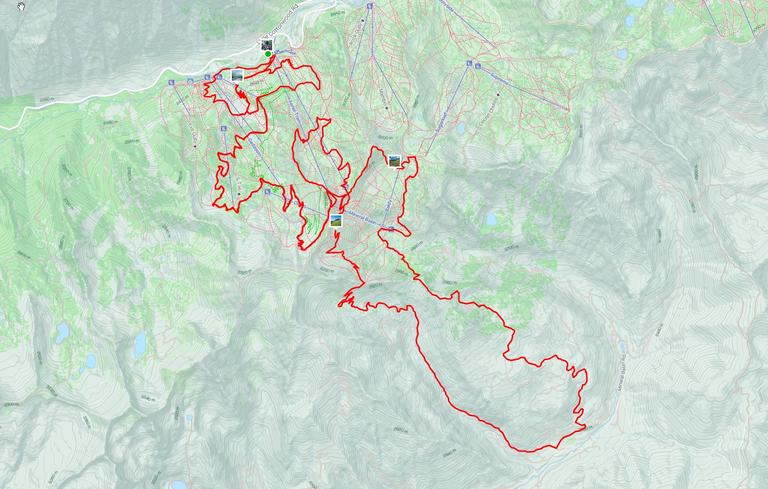
The race has not only matured by absolute number of runners but by corporate ownership. In 2021 it was acquired by UTMB/Ironman. I was surprised at the expansive setup of the venue when I arrived early on July 20 to pick up my bib at around 5AM. There was an entire events tent the size of a small warehouse with temporary vinyl flooring and multiple vendor shops inside. It was as if a miniature running mall had appeared out of nowhere. In 2015 and 2017 the extent of vendor booths were entirely under pop up tents.
Hydration 1
The energy at the beginning of any race is exhilarating. Tapering for weeks after intense training leaves me with tons of pent up energy. Combine that with the music, surging crowd, and anticipating of a monumental day can push me to an unsustainable pace. But I resisted this feeling and held back as we began the long day.
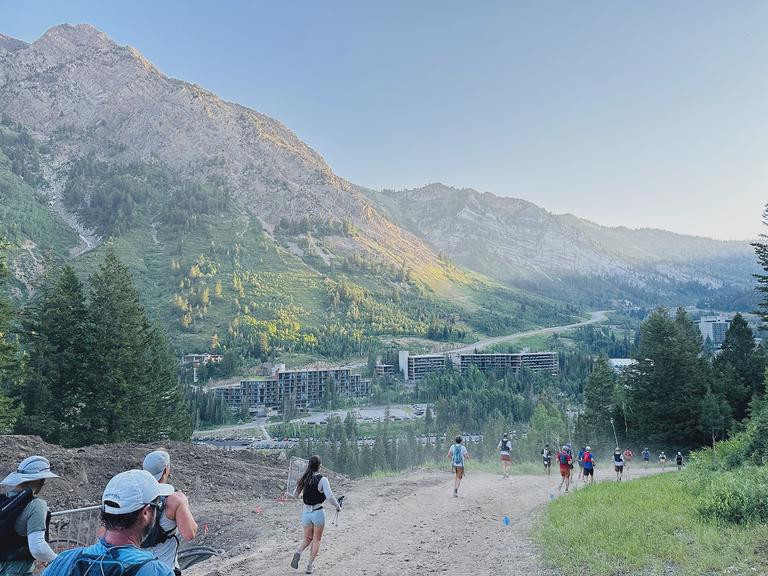
Starting off at 8,080 feet at the Snowbird Plaza the course winds back and forth for 4.2 miles and up 1,656 feet to the first aid station. A few people remarked how we were still in sight of the starting line as we did switch backs across the mountain bench. The course was almost entirely dirt access roads up to this point. This was very helpful to manage the huge crowd of runners before the climb began to thin us out.
Hidden Peak 1
After leaving the first aid station the route became more direct up to Hidden Peak. The dirt access roads gave way to beautiful single track trails. The sun had risen at this point but was behind the mountain peak making the running conditions cool and beautiful.
Although the bulk of the racing crowd had spread out as we all adopted our own pace there was still a concentration of people that overwhelmed the capacity of the single track paths. When the course transitioned from the wider dirt access road to single track there were traffic jams. This became pretty annoying as we ascended up to Hidden Peak but might have been my saving grace. The slower pace at times kept my heart rate under control and avoided giving way to the trap of going too fast.
In this portion of the race I tried to establish my calorie and salt intake. I started with a salt pill at 1:30 to be repeated every hour on the half hour mark. These have 215mg of sodium, 63mg of potassium, 11mg of calcium, and 22mg of calcium. Then, at 2:00 I started taking GU gels at the top of every hour. These have 55mg of sodium, 450mg of amino acids, and 7g of sugar.
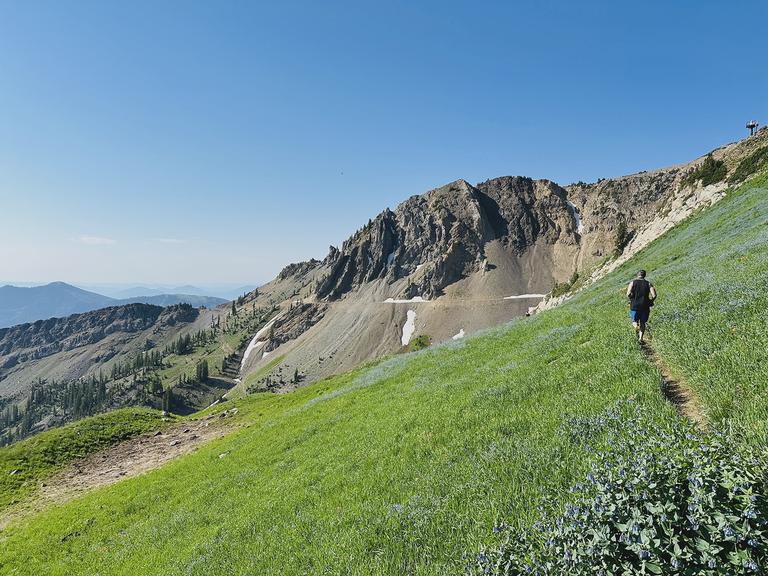
At any point where I was near enough an aid station I substituted my GU gel intake with actual snacks or food. I did this because I wouldn’t wish 10-12 hours of GU intake on my worst enemy and also to manage stomach nausea.
At the Hidden Peak aid station at 9.3 miles and another 2,975 feet of elevation gain I wolfed down my favorite snacks, potato chips, peanut butter stuffed pretzels, Coca-Cola, and a few slices of water melon. This is the most well stocked and populated aid station besides the finish line.
Water Pipe
Between the Hidden Peak aid station to the Water Pipe is the greatest litmus test of your performance for the rest of the race. The downhill profile promises you’ll make up lost time but the terrain is loose apple and melon sized rocks. You have to be incredibly careful as you descend down into Mineral Basin to not roll your ankle or trip. This added a great deal of fatigue on my quads.

After getting to the bottom of Mineral Basin at around 7,600 feet elevation I was relieved to finally be done with the incredibly long and technical descent. This was about 4 hours and 15.4 miles into the course and it was starting to get really hot. In my effort to stay hydrated I had been aggressively consuming water and was almost empty with my front pack water bottles. Luckily I was carrying an additional 2 liters in my backpack hydration reservoir.
The race guidance had directly warned us about this section and had required everyone to carry 2 liters of water for exactly this section. Yet, in years past they had an aide station at the bottom of Mineral Basin that provided a much needed refuel before the long climb back up to the top of Mineral Basin. The course now has moved this aid station to mile 18.1, which is up a long 3 mile climb in the heat.
As I started the hot climb back up Mineral Basin I realized I was exhausted and I changed from a slow jog to a death march. Many runners describe this as hitting the wall. I tried to isolate what could be the cause. I had been slamming water and electrolytes pills on my normal rhythm. I was still sweating so I wasn’t specifically dehydrated. I had also been eating regularly. Certainly a lot more calories than in my training runs.
About a half mile into this internal review process in a zoned out death march I hit another setback. After trying to lift my leg up to get a small pebble out of my shoe the entire back of my left thigh seized up into a cramp. The spasms were surprising considering I had never had cramps in this particular area of my body before and the muscle is pretty large. After taking a short break to relax my leg enough to keep hiking I made sure to slow my pace even more to accommodate for the struggling thigh.
From Hidden Peak to the Water Pipe aid station is 8.7 miles with 3,658 feet of elevation loss and 2,444 feet of elevation gain. In absolute terms this is tolerable. But for many reasons it is where I personally and many other verbal runners around me start to struggle. I think the primary reason is that the race has finished the fun part and with every step becoming more and more about sheer will.
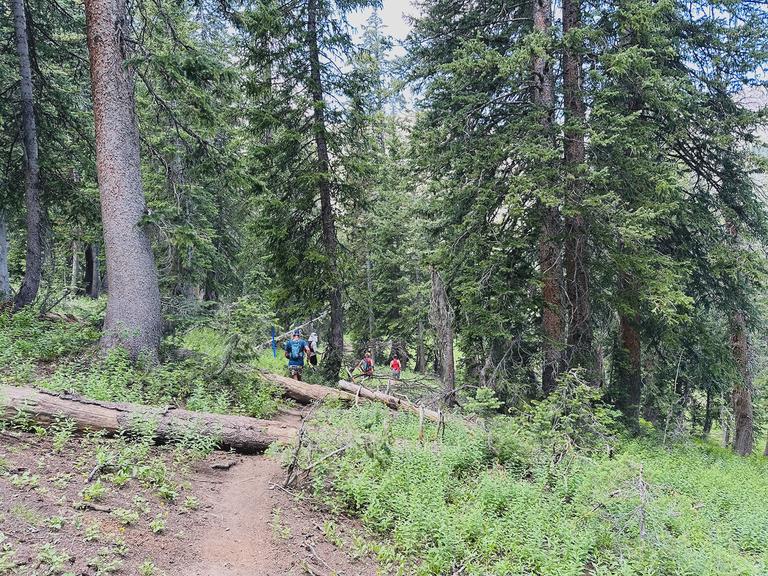
The Water Pipe aid station itself is next to a natural spring with race volunteers gathering water for the parched runners. Although there is no food it isn’t really a problem because the only thing I was thinking about at this point was getting more water and cooling off with a dump of water over my neck.
Mineral Basin
A short 1.4 miles farther and 616 feet of gain I started to realize how hungry I was for snacks. I took my time here at this well stocked aid station. Plenty of potato chips, pickles, pizza, cookies, Coca-Cola, and my favorite: peanut butter pretzels. The placement of the aid station exit sign was looming over my feast. It proudly stated the next hellish segment of the race, up Mount Baldy.
Refreshed from the aid station I started off in the next section with a slow jog on the flatter parts. When the uphill part started a few hundred feet later I slowed to a steady hike. My cramping leg had become more timid and would flare back up occasionally. Much of the winding approach up to Mount Baldy isn’t steep itself but still merits a strong input of will.
As I turned off the dirt access road right before the Mount Baldy climb I heard a group of runners collectively questioning their life’s choices. A few had done Ironman competitions and said this Speedgoat race was harder. A few more said their 100km race wasn’t this hard. All agreed in the camaraderie of misery.
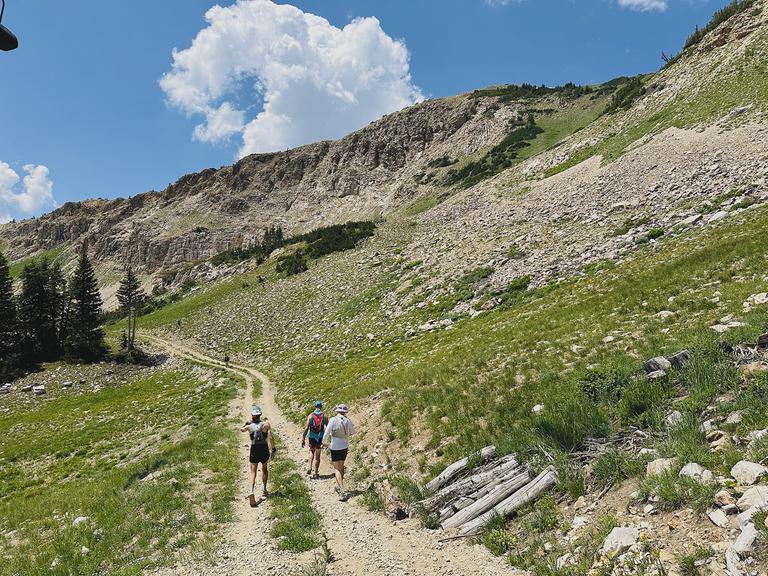
When the trail became unmanageably steep I shortened my steps and focused entirely on placement. The loose dirt and rocks here stole your energy if you were unfortunate enough to slide back down after gathering enough strength to step upward. In the previous times on this race I had opted not to bring hiking poles and always regretted not having them on this section. But this year I came back with revenge and 2 ultralight carbon fiber poles. They gave my climb much needed stability and I was able to use much more of my body to help with the climb.
If I only had a single proud moment in this brutal race it was this last steep climb up Mount Baldy. My steps were tiny and my progress was incredibly slow. But I kept the climb consistent and deliberate without any side step breaks. In a mere 2.6 miles I had gotten closer to the sun by 1,843 feet.
Tunnel
The placement of the Tunnel Aid Station is perplexing. The nirvana of the Hidden Peak Aid Station is up a small hill but instead you bypass it off to the side and wrap around to an interesting tunnel through the mountain. Entering the cool tunnel after the brutal climb up Baldy with the heat ofthe day is one of the greatest feelings. Through the length of the tunnel are photographs and objects from a time long ago. I always find it a shame I don’t stop here to view this hole in the mountain museum.

After exiting the tunnel the aid station is waiting right outside. I gathered my usual snacks and tried to minimize my time here. Slowing down anywhere is a sure way to realize how much pain you are in.
From the Tunnel Aid Station to the bottom of the Hidden Peak ridge is the easiest part of the course. The path is a wide open dirt access road that winds back and forth as I went down the hill. There are small and medium sized rocks on the road so I couldn’t let loose with absolute speed but it was much more manageable than going down the river bed at Mineral Basin. This section goes down 1,128 feet before I started climbing back up again along the Hidden Peak Ridge.
As I started up the Hidden Peak Ridge there were storm clouds starting to form around the peak. This is a semi-regular occurrence in late summer where afternoon thunderstorms roll in briefly and then disappear. I had a sudden fear that all my effort might be wasted if the storm continued to strengthen. Yet, as I slowly climbed the ridge the clouds stayed high and there were no lightning to be seen or thunder to be heard.
Nearing the top of the ridge the wind started to strengthen and patchy rain rolled in. I kept my pace in an earnest effort to beat the storm. After Hidden Peak it was almost entirely downhill to the finish line. From the Tunnel Aid Station I had gone 2.7 miles with an elevation gain of 1,535 feet.
It was here that an event photographer had stationed himself and was snapping away to capture my absolute misery. I understand it is logistically easiest to access this spot since it was a short walk down from Hidden Peak. However, the choice of capturing a runner’s image at the height of discomfort is odd to me. Other runners might experience reaching the top of the ridge with ecstasy on their face. Mine was just dead. I nonchalantly told the photographer as I passed him I felt like I was dying. He tried to disarm the situation by saying everyone is dying. I laughed at that but quipped back that I felt closer than most.
Hidden Peak 2
At the last few hundred feet before reaching the Hidden Peak Aid station there were race officials waiting for me. Fearing a canceled race due to lightning risk or I hadn’t made the cutoff time I approached them slowly. As I got to them they just instructed me to take the low road around the back of Hidden Peak to avoid the wide open exposure of the last hill climb up to the top. Although the aid station is higher it is next to buildings that would theoretically attract a lightning strike. Despite the extra distance around the low road I was grateful to avoid getting struck by lightning.
As I reached the aid station the race crew was packing up the bulk of tables and tents. I realized 9 hours and 44 minutes had passed and I was still miles away from the finish. I was glad I had kept my forward progress without getting cut or quitting but it was still frustrating to see once again how far back in the pack I was.
During these broody thoughts I was ushered by a race official towards a checkpoint. Since I had taken the low road I had to loop back slightly to get my bib scanned for the aid station. I realized the race official was none other than Karl Meltzer himself. I told him I was in a love hate relationship with him. He feigned a laugh since I’m 100% sure he’s heard that a million times before.
Hydration 2
I set off from Hidden Peak quite excited for the last part of the race. Much of it is downhill but there are a few surprises that always get me and other swearing. Towards the middle of the 5 miles before reaching Hydration #2 there is a series of hill climbs up 748 feet that hit at the worst possible time. Since I was so close to the finish I could strive forward in confidence but it as incredibly slow up the last hill climbs. It feels as if I was robbed of a graceful finish. To suddenly go from a speedy downhill jog to a trudge up more hills is greatly demoralizing. Over the 5 mile portion of the course I lost 3,047 feet of elevation.
It is interesting to experience the last 7 miles of this race. Psychologically, you have to balance levels of pain and the duration I’d have to stay with that pain. Meaning I could minimize my pain by power hiking at a 16 to 20 minute per mile pace instead of running at a 9 to 12 minute. But this would almost double the duration of that minimized pain. Logically, the better choice would be to run. It wasn’t as if I was going to injure or damage myself from the quicker jog. Yet, the decision for me flipped back and forth between walking and running.
The last few miles were a blur of pain as I tried to ignore my discomfort for the sake of finishing any faster than what a slow walk would give me. Once again they had stationed an event photograph only half a mile from the finish to capture me at my most dismal. The official distance and elevation gain was 31.8 miles and 11,318 feet. My Garmin Fenix 7x recorded 32.9 miles and 11,138 feet.
I would have expected someone’s third race attempt to have improved performance. But I didn’t fulfill my speed or comfort goals. I wanted to feel strong throughout the race but instead I felt dead after only 16 miles. My confidence isn’t shattered but I am once again humbled to improve my training. I won’t shy away from doing this again in the future and look forward to further mental demoralization.